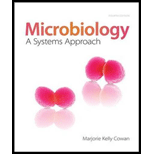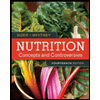
Microbiology: A Systems Approach
4th Edition
ISBN: 9780073402437
Author: Marjorie Kelly Cowan Professor
Publisher: McGraw-Hill Education
expand_more
expand_more
format_list_bulleted
Question
Chapter 25.2, Problem 5AYP
Summary Introduction
To describe:
The primary and secondary phases of sewage treatment.
Concept introduction:
In cities, drinking water requires treatment before being sent to consumers. In a treatment plant, the reservoir water is filtered, disinfected, and supplied for use. To make the disposed of sewage water absolutely devoid of toxins before being released into water bodies, it is passed through three main stages of treatment- primary, secondary, and tertiary phases. Use of microbes is an important part of the complete treatment of water.
Expert Solution & Answer
Want to see the full answer?
Check out a sample textbook solution
Students have asked these similar questions
Which evidence-based stress management techniques are most effective in reducing chronic stress and supporting college students’ academic success?
students in a science class investiged the conditions under which corn seeds would germinate most successfully. BAsed on the results which of these factors appears most important for successful corn seed germination.
I want to write the given physician orders in the kardex form
Chapter 25 Solutions
Microbiology: A Systems Approach
Ch. 25.1 - Compose a sentence about the history of applied...Ch. 25.1 - Define biotechnology, and explain how its uses...Ch. 25.2 - Outline the steps in water purification.Ch. 25.2 - Differentiate water purification from sewage...Ch. 25.2 - Prob. 5AYPCh. 25.2 - Prob. 6AYPCh. 25.2 - List five important pathogens of drinking water.Ch. 25.2 - Provide examples of indicator bacteria, and...Ch. 25.2 - Summarize methods for identifying and quantifying...Ch. 25.3 - Prob. 2CF
Ch. 25.3 - Name five foods and/or beverages that are produced...Ch. 25.3 - Summarize the microbial process that leads to...Ch. 25.3 - Write the equation showing how yeasts convert...Ch. 25.3 - Discuss how microorganisms themselves are useful...Ch. 25.3 - Provide background on current HACCP guidelines,...Ch. 25.3 - Prob. 15AYPCh. 25.3 - Outline basic principles of using temperature to...Ch. 25.3 - List methods other than temperature currently used...Ch. 25.4 - Prob. 18AYPCh. 25.4 - Distinguish between primary and secondary...Ch. 25.4 - List the four steps of industrial product...Ch. 25.4 - Identify five industrial products made by...Ch. 25 - Prob. 1CFCh. 25 - Drinking water utilities monitor their production...Ch. 25 - Milk is usually pasteurized by a. the...Ch. 25 - During sewage treatment, microbial action on a...Ch. 25 - Which of the following is unlikely to be a...Ch. 25 - The bloom in wine making refers to a. the...Ch. 25 - When algae produce biofuels, what is the other...Ch. 25 - Secondary metabolites of microbes are formed...Ch. 25 - In industrial fermentation, which step precedes...Ch. 25 - Which of the following is currently being produced...Ch. 25 - In biotechnology, fermentation refers to a. the...Ch. 25 - Prob. 11TFCh. 25 - Food products should always be kept completely...Ch. 25 - Alcoholic beverages are produced by the...Ch. 25 - Prob. 14TFCh. 25 - Refrigerating food prevents the growth of all...Ch. 25 - a.Summarize one beneficial use of sludge today,...Ch. 25 - Every year, supposedly safe municipal water...Ch. 25 - Provide evidence in support of or refuting the...Ch. 25 - a.List examples of microbes used in the production...Ch. 25 - Prob. 5CTQCh. 25 - Prob. 6CTQCh. 25 - Prob. 7CTQCh. 25 - Further investigate the HACCP system, and...Ch. 25 - Prob. 9CTQCh. 25 - Prob. 10CTQCh. 25 - Prob. 1CCCh. 25 - Prob. 2CCCh. 25 - Prob. 3CCCh. 25 - Prob. 4CCCh. 25 - Prob. 5CCCh. 25 - Prob. 6CCCh. 25 - Prob. 7CCCh. 25 - From chapter 3, figure 3.5b. If this MacConkey...Ch. 25 - Prob. 2VCCh. 25 - Using the words that follow, please create a...
Knowledge Booster
Learn more about
Need a deep-dive on the concept behind this application? Look no further. Learn more about this topic, biology and related others by exploring similar questions and additional content below.Similar questions
- Amino Acid Coclow TABle 3' Gly Phe Leu (G) (F) (L) 3- Val (V) Arg (R) Ser (S) Ala (A) Lys (K) CAG G Glu Asp (E) (D) Ser (S) CCCAGUCAGUCAGUCAG 0204 C U A G C Asn (N) G 4 A AGU C GU (5) AC C UGA A G5 C CUGACUGACUGACUGAC Thr (T) Met (M) lle £€ (1) U 4 G Tyr Σε (Y) U Cys (C) C A G Trp (W) 3' U C A Leu בוט His Pro (P) ££ (H) Gin (Q) Arg 흐름 (R) (L) Start Stop 8. Transcription and Translation Practice: (Video 10-1 and 10-2) A. Below is the sense strand of a DNA gene. Using the sense strand, create the antisense DNA strand and label the 5' and 3' ends. B. Use the antisense strand that you create in part A as a template to create the mRNA transcript of the gene and label the 5' and 3' ends. C. Translate the mRNA you produced in part B into the polypeptide sequence making sure to follow all the rules of translation. 5'-AGCATGACTAATAGTTGTTGAGCTGTC-3' (sense strand) 4arrow_forwardWhat is the structure and function of Eukaryotic cells, including their organelles? How are Eukaryotic cells different than Prokaryotic cells, in terms of evolution which form of the cell might have came first? How do Eukaryotic cells become malignant (cancerous)?arrow_forwardWhat are the roles of DNA and proteins inside of the cell? What are the building blocks or molecular components of the DNA and proteins? How are proteins produced within the cell? What connection is there between DNA, proteins, and the cell cycle? What is the relationship between DNA, proteins, and Cancer?arrow_forward
- please fill in the empty sports, thank you!arrow_forwardIn one paragraph show how atoms and they're structure are related to the structure of dna and proteins. Talk about what atoms are. what they're made of, why chemical bonding is important to DNA?arrow_forwardWhat are the structure and properties of atoms and chemical bonds (especially how they relate to DNA and proteins).arrow_forward
- The Sentinel Cell: Nature’s Answer to Cancer?arrow_forwardMolecular Biology Question You are working to characterize a novel protein in mice. Analysis shows that high levels of the primary transcript that codes for this protein are found in tissue from the brain, muscle, liver, and pancreas. However, an antibody that recognizes the C-terminal portion of the protein indicates that the protein is present in brain, muscle, and liver, but not in the pancreas. What is the most likely explanation for this result?arrow_forwardMolecular Biology Explain/discuss how “slow stop” and “quick/fast stop” mutants wereused to identify different protein involved in DNA replication in E. coli.arrow_forward
arrow_back_ios
SEE MORE QUESTIONS
arrow_forward_ios
Recommended textbooks for you
- Basic Clinical Lab Competencies for Respiratory C...NursingISBN:9781285244662Author:WhitePublisher:Cengage
 Nutrition: Concepts and Controversies - Standalo...Health & NutritionISBN:9781305627994Author:Frances Sizer, Ellie WhitneyPublisher:Brooks Cole
Nutrition: Concepts and Controversies - Standalo...Health & NutritionISBN:9781305627994Author:Frances Sizer, Ellie WhitneyPublisher:Brooks Cole


Basic Clinical Lab Competencies for Respiratory C...
Nursing
ISBN:9781285244662
Author:White
Publisher:Cengage



Nutrition: Concepts and Controversies - Standalo...
Health & Nutrition
ISBN:9781305627994
Author:Frances Sizer, Ellie Whitney
Publisher:Brooks Cole

Photosynthesis & Respiration | Reactions | Chemistry | FuseSchool; Author: FuseSchool - Global Education;https://www.youtube.com/watch?v=3XIyweZg6Sw;License: Standard YouTube License, CC-BY